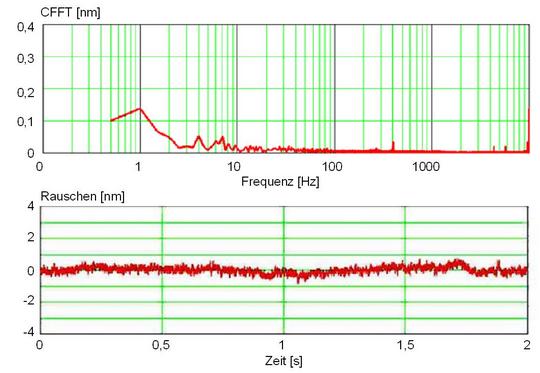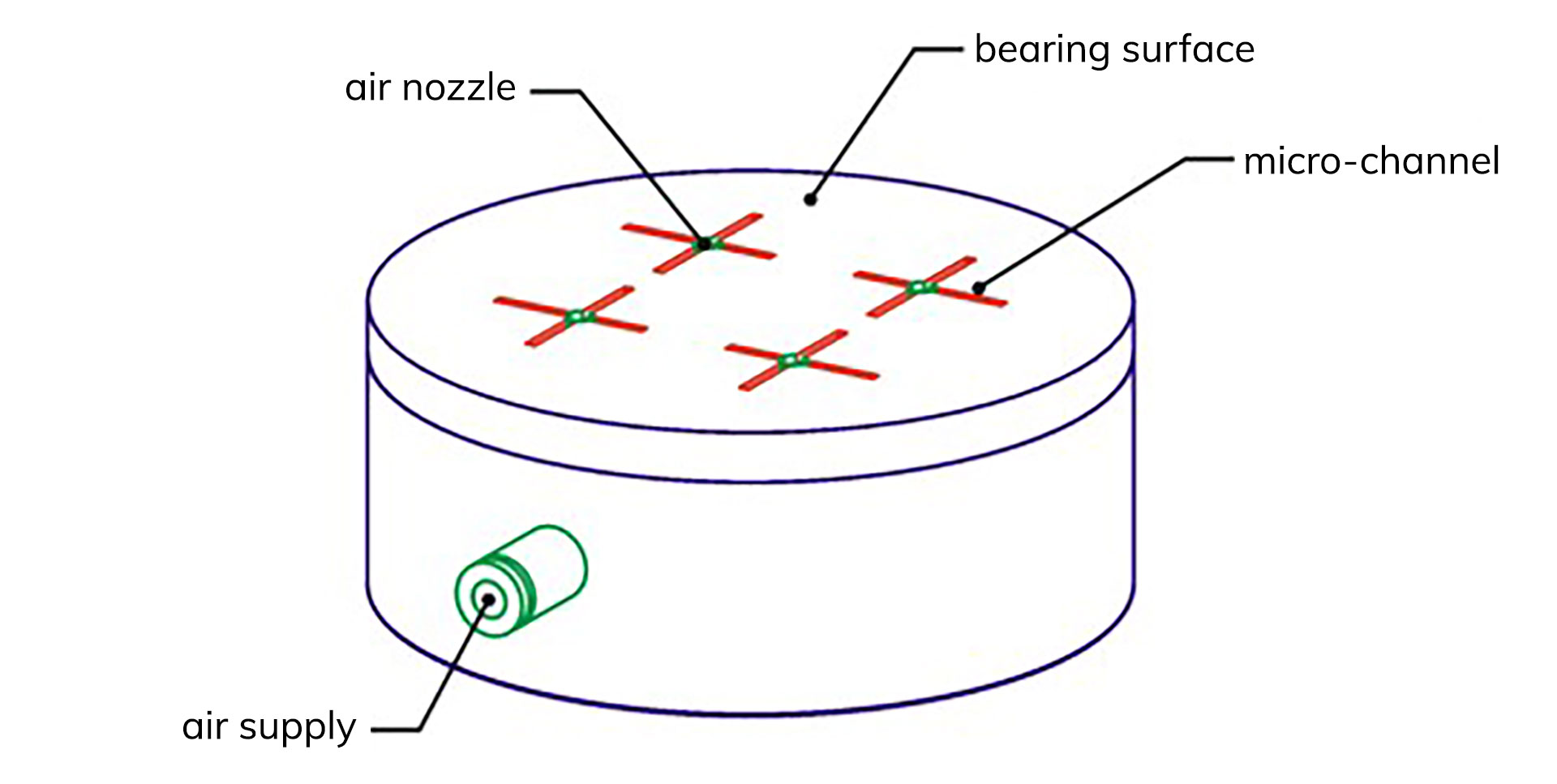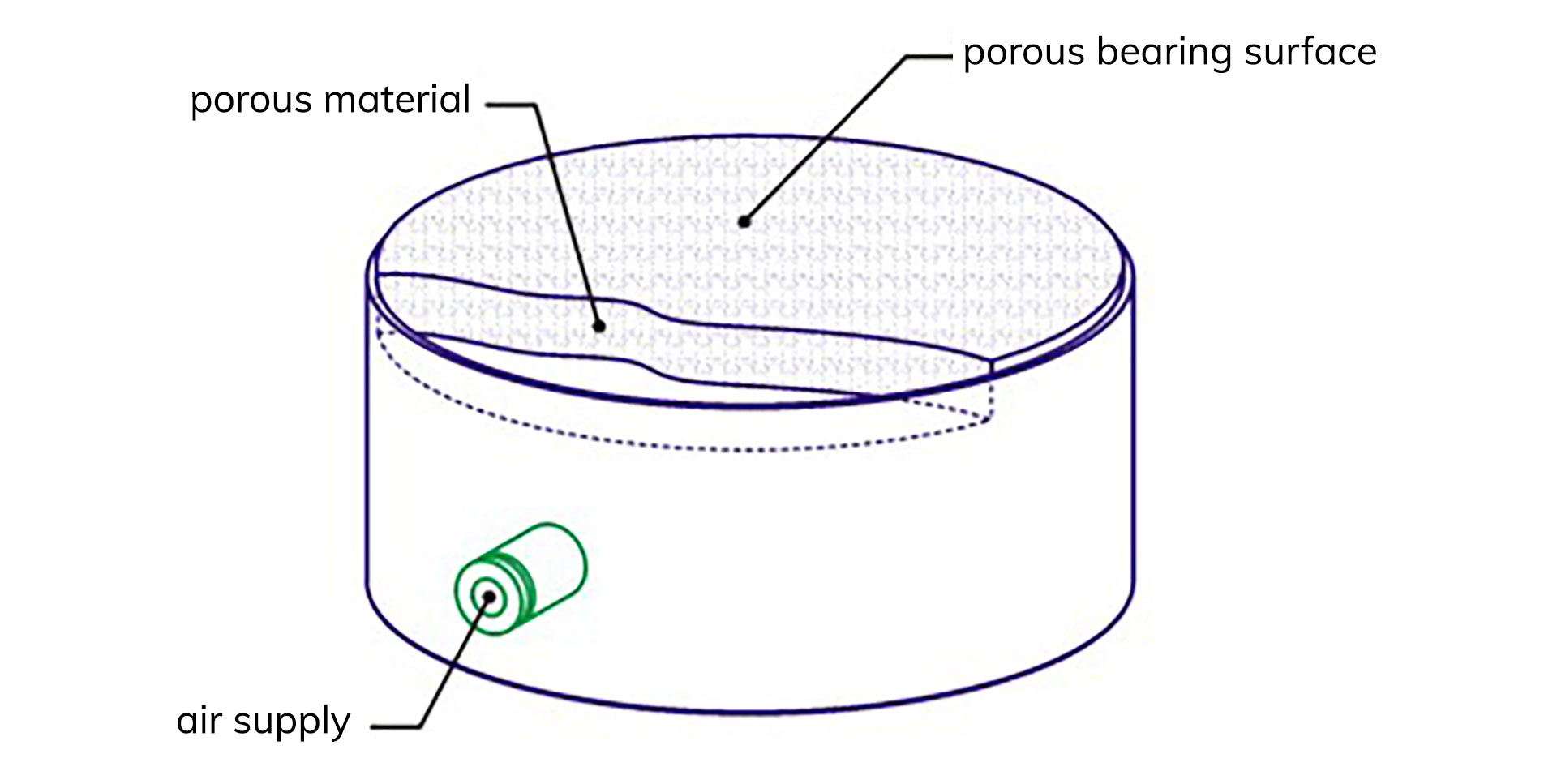Air Bearing Technology by AeroLas
On a physical level, the basic technology with laser-drilled air nozzles provides the most efficient air-bearing solution on the market, i.e. the air is perfectly used as a contact-free lubrication medium. It delivers outstanding bearing characteristics, such as load capacity, stiffness, tilt stiffness and damping, relative to the air consumption and air gap height. Compared to conventional air-bearings, it offers minimal operating costs at a higher performance. The static and dynamic properties of the air-bearings can be optimised for a specific application by varying the nozzle geometry, the position of the nozzles and their distribution. In all other air-bearings, however, the bearing properties influence each other: a crucial disadvantage.

Upon technical implementation, the outstanding bearing properties offered by AeroLas’s air-bearing innovations provide application-focused possibilities that go far beyond what conventional air-bearing solutions could ever deliver. Sample implementations include: accelerations over 2,500 m/s² for linear drives, or even over 100,000 m/s² for shock drives as a result of the high damping and dynamic stiffness; positioning in the sub-nanometre range due to the low noise level; contact-free transmission of supply gases or vacuum for rotary or linear drives via the bearing gap, thanks to targeted air guidance.

AeroLas’s air-bearings have a large number of micro nozzles rather than a few large nozzles with channel structures, which avoids dynamically harmful dead volumes. Dead volumes refer to all cavities in which air cannot be compressed as the bearing gap changes. These are even present in air-bearings made from porous material. Dead volumes are like a soft gas spring that encourages oscillation. Dead volumes include, in particular, chambers and/or channels used in conventional air-bearings to distribute the air evenly and increase the pressure in the bearing gap. Hollow spaces in the material used for air-bearings made from porous bearing material (sintered air-bearings) are equally as detrimental.
At AeroLas, the effective, almost optimal pressure profile in the bearing gap, is achieved with a multitude of air nozzles with diameters ranging from 0.02 mm to 0.06 mm. Their most narrow cross-section is located directly in the bearing surface. In doing so, dead volumes can not only be prevented at the bearing surface but also in the area of the air inlet nozzles.
The micro nozzles are drilled automatically by laser with the highest quality and reproducibility. The physical air-bearing properties show minimal variation in both small and large series. Manual, expensive manufacturing steps common in conventional air-bearings, are omitted.
AeroLas calculates the number, geometry and distribution of air nozzles required using fundamental theories and a software developed in-house. As a result, air-bearing properties can be adjusted optimally to the customer’s requirements.
Benefits of AeroLas’s Air-Bearing Technology
High flexibility, equally outstanding static and dynamic properties and minimal noise excitation are, amongst others, proven unique selling points compared to all other air-bearings.
- efficient use of air cushion thanks to a uniform pressure level in the entire bearing gap
- optimal combination of static and dynamic air-bearing properties
- highest possible flexibility to determine different air-bearing properties: e.g. maximum load capacity, stiffness, tilt stiffness, damping or minimal air consumption at a certain bearing gap height, or a combination of these, can be optimised
- highest accuracy, e.g. in measurement technology, due to imperceptibly small interference movements (<2 nanometres) and to the smallest physically possible noise excitation
- significantly higher tilt stiffness compared to conventional air-bearings, in which air in the bearing gap flows through the channels from the loaded to the unloaded areas
- free from vibrations over the entire operating chain even at very high supply pressures – up to 30 bar in some cases
- highest functional reliability thanks to a high number of air nozzles: obstruction of air nozzles through particles is virtually impossible, since their diameter is significantly larger than the bearing gap height (as verified in series products)
- possibility to adjust bearing characteristics to deformations/tolerances of the bearing and support surfaces
- applicable for a wide range of bearing materials and coatings
How AeroLas’s Air Bearing Technology Compares to Conventional Air-Bearings
Classification
Air-bearings (aerostatic bearings) fall under the category of slide bearings. Compressed air pushed into the bearing gap, i.e. between the surfaces sliding past each other, forms the lubricating medium. It is used to establish a pressure cushion that supports the load without contact. The compressed air is typically supplied by a compressor, though the bearing characteristics depend on the pressure level provided. The pressure is aimed to deliver the highest possible degree of stiffness and damping of the air cushion. The air consumption and equal distribution of air over the entire bearing surface play a crucial role.
AeroLas’s air-bearings deliver the highest performance
AeroLas’s innovative air-bearings feature a large number of air nozzles drilled precisely by laser. Their dead volumes are imperceptibly small compared to all other air-bearings. The number, distribution and geometry of the micro nozzles are precisely calculated. In doing so, the bearing properties can be optimally adjusted to customer requirements. The large number of nozzles delivers almost endless variations between static and dynamic properties. This way, the air-bearing technology is far superior to others in every way. Furthermore, solutions are possible that far exceed what conventional air-bearings could deliver towards rolling and plain bearings.
In conventional air-bearings, compressed air typically flows into the bearing gap via few but relatively large nozzles (diameter 0.1 - 0.5 mm). As a result, their air consumption is not very flexible and bearing characteristics cannot be adjusted sufficiently to surrounding parameters (forces, moments, bearing area, bearing gap height, damping). To achieve the most uniform air distribution in the gap despite the small number of nozzles, various design measures must be taken. These, however, create dead volumes, i.e. non-compressible and therefore soft air volumes. They are extremely detrimental to the air-bearing dynamics, encouraging noise and self-excited vibrations.

Design of a typical conventional air-bearing

Single-nozzle air-bearing
Since the late 1980s, air-bearings with micro-channel structures without chambers have been produced by some manufacturers. Disadvantages with dead volumes remain, however. Compared to the air-bearing technology offered by AeroLas, these micro-channels have a sharp decline in load carrying capacity and stiffness as the bearing gap height increases. This explains why they are particularly unfavourable for dynamic applications such as high-acceleration linear drives, or high-frequency spindles.

Air-bearing with micro-channel

Sintered air-bearings with porous material
Customer benefits
Many of our customers originally manufactured their air-bearings themselves, are competitors, or switched over to us from using competitor components for their manufacturing of air-guided systems.
AeroLas’s unique know-how and the distinctive advantages of its air-bearing technology were the driving forces behind this.
Advantages of AeroLas’s air-bearings
AeroLas’s innovative air-bearings provide a significant increase in performance against conventional air-bearings, as well as distinctive advantages in their dynamics and accuracy compared to roller bearings. It is therefore only a matter of time until the ongoing replacement for precision drives in production technology with air-bearings is complete. There are ecological advantages to air-bearings, particularly towards oil and grease-lubricated slide bearings.
Technical Criterion | AeroLas’s air-bearings | Conventional air-bearings | Rolling bearings | Hydrostatic glide bearings | Hydrostatic glide bearings | Magnet bearings |
|---|---|---|---|---|---|---|
Production costs (large series) | +/++ | --/- | ++ | -- | ++ | -- |
Operating costs | + | - | +/++ | -- | +/++ | -/+ |
Friction reduction | ++ | ++ | - | + | - | ++ |
Guidance accuracy | ++ | +/++ | - | + | --/- | +/++ |
Positioning accuracy | ++ | ++ | --/- | + | -- | +/++ |
Load capacity | + | -/+ | ++ | ++ | ++ | ++ |
Stiffness | + | -/+ | +/++ | ++ | --/- | ++ |
High acceleration | ++ | -/+ | - | ++ | -/+ | + |
High acceleration/RPM | ++ | +/++ | - | ++ | --/- | + |
Oscillation damping | ++ | -/+ | --/- | ++ | -/+ | + |
Heat avoidance | ++ | ++ | - | ++ | --/- | + |
Emergency operation after failure | + | -/+ | +/++ | - | + | -- |
Life span | ++ | ++ | + | +/++ | + | +/++ |
Low noise (smoothness) | ++ | + | -- | + | + | ++ |
Environmentally friendly | ++ | ++ | - | -- | - | + |
Constructive adaptation | ++ | -/+ | --/- | - | - | + |
Comparison of different bearing types from ++ (very good) to -- (very poor).
The advantages can be summarised as follows:
- Speed, acceleration:
for precision applications at high accelerations, conventional air-bearings are not a suitable alternative to rolling bearings. This is because accelerations common nowadays (up to 200 m/s²) cannot be reached. AeroLas’s air-bearings, however, are used in series production (packaging industry) with accelerations up to 2,500 m/s². The combination of acceleration and precision (repeatability / positioning accuracy) increases the productivity in automated machinery used in the semiconductor and electronics industry. Currently, the reachable speed in these pick-and-place systems is not a problem because distances are usually short. AeroLas’s air-bearings, however, are also able to reach high speeds (over 50 m/s), which are far superior to conventional air-bearings (4-5 m/s). - Guidance, repetition / positioning accuracy:
even nowadays, chip production requires repetition accuracies of 1-2 µm in the back-end. With roller bearings, physical limits are reached unless accelerations are reduced concurrently. In the front-end (lithography), air-bearings are already in use. Here, the superior guidance accuracy offered by AeroLas’s technology, which combined with the coordinated drive control, provides advantages and benefits that conventional air-bearing solutions are unable to deliver. Currently, accuracy requirements for pick-and-place systems in electronics production increase rapidly due to the uptake of smaller components and technology changes, e.g. chip-on-board, flip-chip technology or wafer-level chip scale packaging. Similarly, repetition accuracies of less than 5 µm will therefore be required, however can no longer be delivered by roller bearings because of the stick-slip and ‘drawer’ effect. Here, AeroLas’s air-bearings provide the prerequisites for future productivity requirements at a high level of purity (free from oil and grease). - Free from erosion, lifespan:
air-bearings operate in a contactless manner and, when in use, have no solid-state friction (only air friction in the gap). Their lifespan is therefore practically unlimited, with continuous air supply. Roller or glide bearings experience significant wear, particularly at high accelerations, which leads to a reduction in the guidance accuracy and consequently failure. Many hundreds of air-bearings from AeroLas are already successfully in use worldwide, in highly sought-after series applications. This success is down to AeroLas’s testing of many different bearing combinations (basic material / coating) to guarantee a safe series operation. Customer-specific requirements are also taken into account here. Most importantly, the impact of ‘dry running’ (without air) on bearing properties was investigated. Objectively speaking, not every ‘emergency coating’ that is referred to as such (also by competitors) withstands the high requirements needed for air-bearings. Series use is the only proof! - Safe from self-excited vibrations:
self-excited vibrations are generally considered a significant disadvantage of conventional air-bearings. Not enough, or nothing at all, is known about the underlying physical reasons by the manufacturers of these bearings. Even well-known bearing manufacturers therefore experience this problem in applications that require commonly used supply pressures of up to 5 bar. AeroLas’s technology does not include any chambers or channels in the bearing surface, which are largely responsible for vibrations. For this reason, AeroLas’s air-bearings are less prone to self-excited vibrations. Even supply pressures of up to 6 bar can be handled well. In addition, AeroLas thoroughly analysed these vibrations and can calculate the threshold at which they occur, in order to take countermeasures. - Cost advantages / reproducibility:
manual processing steps common for conventional air-bearings (insertion of air-inlet nozzles) are replaced by the patented laser drilling used for AeroLas’s air-bearings. It is characterised by maximum reproducibility, full automation and reduced costs thanks to the fast processing. The technology can therefore be used for the first time in large series, e.g. in printing, textile or automotive technology. In series production, air-bearings even offer cost advantages towards roller bearings. According to a competent manufacturer of roller and air-guided spindles, roller-guided high-frequency spindles are 20% more expensive than air-guided equivalents. - Purity, free from oil and grease:
chip production predominately takes place in a clean room. Even minimal pollution can cause defects and therefore high costs. In electronics production, the purity standards in the surrounding environment also increase with smaller components. Air other than oil / grease is an optimal lubricant because it is available in the same purity as the surrounding air. With air lubrication, there is therefore no need for a complex sealing of the bearing. - Ecological advantages:
the elimination of environmentally harmful, mineral oil-based or synthetic lubricants currently increases the interest in air-bearings, also outside of traditional markets. The cost advantages of AeroLas’s technology due to the fully automated processing (laser drilling) offer enormous advantages in large-series applications.

